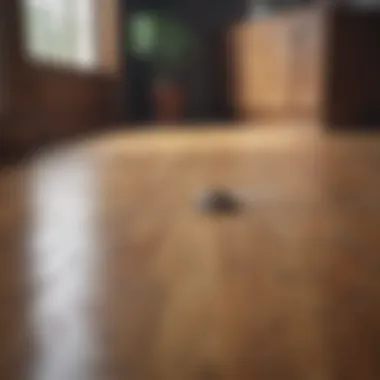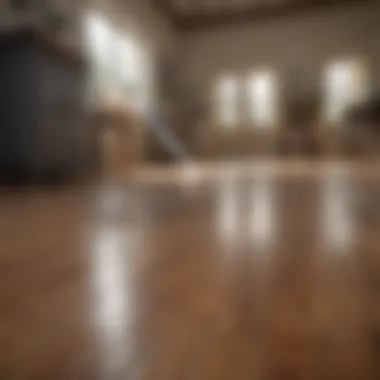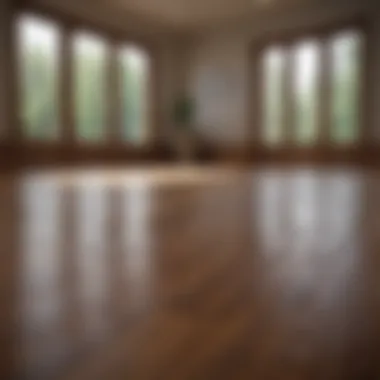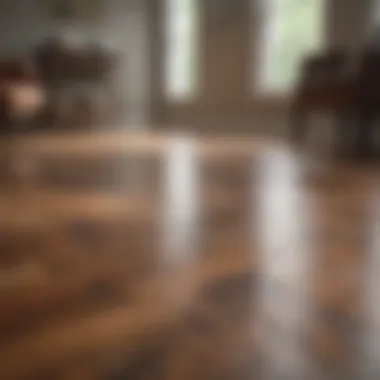Cleaning Wood Floors: Natural and Commercial Solutions


Intro
Maintaining the beauty and durability of wood floors is a task many homeowners face. Wood flooring, with its unique charm, often becomes a focal point of any room. However, keeping these surfaces clean and striking can be quite a challenge. The art of cleaning wood floors goes beyond just running a mop or a vacuum over them. It requires understanding the specific needs of the wood type, the kind of finish applied, and the various cleaning solutions available.
In this guide, we will delve into effective cleaning solutions, exploring both natural and commercial options. We'll clear up some of the dust and misconceptions that often cloud the discussion about wood floor maintenance, ensuring that even the most discerning real estate enthusiasts and design aficionados are equipped with the right knowledge.
The following sections will highlight key points, such as how to choose the right cleaning method, the importance of regular maintenance, and insider tips to prolong the life of your floors. Whether you're preparing your home for sale or simply want to preserve your investment, a thorough understanding of wood floor cleaning is paramount.
Foreword to Wood Floor Care
Taking care of wood floors is not just a matter of aesthetics; it’s about preserving the very essence of your home. These floors, often a major investment in terms of both time and finances, deserve attention and careful maintenance. Understanding how to care for them properly can mean the difference between a timeless beauty and a space that looks worn out in just a few years. In this section, we’ll delve into the critical aspects of wood floor care, highlighting why it’s essential and how it can enhance the durability of your flooring.
Understanding Wood Floors
Wood floors have a rich history and timeless appeal that many appreciate. Whether it’s oak, maple, or a more exotic type like mahogany, each wood type has its characteristics and maintenance needs. One thing to keep in mind is that wood is a natural product; it expands and contracts with changes in humidity and temperature. This means that the way you care for your wood floors has to take these environmental factors into account.
Key Factors to Consider:
- Moisture Sensitivity: Wood can be particularly vulnerable to water damage. Even a small spill can lead to stains or warping if not dealt with promptly.
- Finish Types: Different finishes (like oil, lacquer, or polyurethane) require unique cleaning methods and products, making it crucial to identify what type your floor has.
- Traffic Levels: Homes with a lot of foot traffic will experience more wear and tear, thus necessitating a more rigorous cleaning and maintenance schedule.
Understanding these factors lays the groundwork for implementing effective cleaning solutions and keeping your floors looking their best.
The Importance of Proper Cleaning
Cleaning wood floors properly goes beyond just eliminating dirt and grime. It plays a fundamental role in extending the life of your floors and preserving the elegance they bring to your home. Regular cleaning can prevent scratches from dirt particles that get ground into the finish. Additionally, the correct cleaning routine aids in maintaining the natural sheen of the wood, keeping it vibrant and full of character.
Benefits of Proper Cleaning:
- Enhanced Longevity: Proper maintenance can significantly extend the lifespan of your wood flooring.
- Aesthetic Appeal: Regular cleaning keeps the surface spotless, highlighting the wood’s natural beauty and grain.
- Healthier Environment: Clean floors contribute to better indoor air quality, as they reduce dust and allergens.
"An ounce of prevention is worth a pound of cure." This old saying rings especially true when it comes to wood floor care. By investing time in the right cleaning practices now, you can save yourself larger headaches later.
In summary, taking these factors into account when cleaning wood floors isn’t just nice, it’s necessary. From understanding the materials to following a proper cleaning regimen, these steps are crucial for anyone hoping to maintain the beauty and functionality of their floors.
Common Challenges with Wood Floors
Wood floors grace many homes with their charm and elegance. Yet, the beauty of these surfaces comes with its own set of trials. Understanding common challenges with wood floors is key to maintaining their quality and ensuring their longevity. Whether it’s the scratches that break up the perfect finish or the lurking stains that refuse to budge, these issues can prompt worry for any homeowner.
By addressing these challenges directly, one can implement appropriate preventative measures and interventions. This part of the article dives into two significant challenges that wood floors face — scratches and scuff marks, alongside water damage and stains. Each category presents unique problems and solutions.
Scratches and Scuff Marks
Scratches and scuff marks can be a persistent source of frustration. Just one errant piece of furniture or the swift movement of a pet can leave a lasting impression on your beautiful wood floor. These marks aren’t merely cosmetic; they can also compromise the protective finish of the wood, leaving it vulnerable to further damage.
To combat scratches:
- Prevention is your best ally. Use felt pads under furniture legs, ensuring that moving items doesn’t result in nasty scrapes that ruin the floor’s appearance.
- Rug placement can also be a game changer. Strategically placing area rugs in high-traffic spots not only protects the wood but also adds a design element to your decor.
When it comes to dealing with existing scratches, there’s an array of techniques. For minor scuffs, a simple rubbing with a cloth dipped in mineral oil might just do the trick, easing the appearance back to a near-perfect finish. If you’re looking at deeper scratches, consider a wood repair marker or touch-up pen, which can effectively mask imperfections.
"A beautiful floor tells stories, and scratches add character, but too many can overshadow its charm."
Water Damage and Stains


Water and wood floors share a complicated relationship. While wood is naturally prone to absorbing moisture, excessive water can lead to unpleasant consequences like warping, swelling, and stains. It’s a real conundrum — a bit of water is necessary for cleaning, yet too much spells disaster.
To mitigate potential water damage:
- Prompt action is key. Immediately wipe up any spills or puddles, preventing them from soaking into the wood.
- Maintain humidity levels in your home, as fluctuations can strain the wood. A humidistat can be an excellent investment in this regard.
Once the damage is done, fixing water stains can be tricky. Light stains can sometimes be treated with a blend of baking soda and water, creating a gentle abrasive that lifts stains without harming the wood’s surface. For more severe issues, a professional refinishing job may be required to restore the floor’s integrity fully.
In summary, addressing these common challenges not only protects the visual appeal of your wood floors but also ensures their durability. Through careful attention to detail and consistent maintenance practices, you can keep your wood floors looking as splendid as the day they were installed.
Natural Cleaning Solutions
Natural cleaning solutions are an essential part of maintaining wood floors, offering effective and environmentally friendly options. They typically avoid harmful chemicals often found in commercial cleaners, making them safer for both your family and pets. These solutions are simple to prepare, often using household staples that provide remarkable cleaning power. When you choose natural cleaning methods, you not only protect your investment in your wood flooring but also contribute to a healthier home environment.
Vinegar and Water Mixture
Vinegar, a household staple, is renowned for its versatility. When it comes to cleaning wood floors, mixing vinegar with water creates an effective solution for combating grime and dirt. This mixture can lift away residues without damaging the finish.
To create a vinegar and water cleaning solution, simply blend one part vinegar with two parts warm water. See, it’s quite straightforward. Tip: Always test this solution on a small, inconspicuous area before applying it to the entire floor. Though vinegar is gentle, some wood types might react differently.
An added benefit of this solution is the natural deodorizing properties of vinegar. It eliminates odors, leaving your home smelling fresh without overwhelming scents. However, it’s important to be cautious. Excessive moisture, even from a natural solution, can lead to water damage if not properly managed. Use a damp mop rather than soaking the floor to avoid such mishaps.
Olive Oil and Vinegar Combination
Combining olive oil and vinegar can make a gentle yet effective cleaner that not only cleans but also conditions the wood. This duo brings together the cleaning power of vinegar and the nourishing qualities of olive oil.
For this mixture, use 1/4 cup of vinegar, 1 cup of olive oil, and a few drops of your preferred essential oil for a pleasant scent. This ratio works well for most wood floors. When applied, this cleaner can effectively remove dirt while simultaneously enhancing the shine of your floors.
Essential Oils for Wood Floors
Essential oils offer additional benefits when cleaning wood floors. They carry delightful fragrances and some even possess antibacterial properties. Some popular oils that you can use include lavender, lemon, or tea tree oil. These oils can be added to your vinegar and water solution to provide an aromatic cleaning experience that also maintains the cleanliness of the wood.
To incorporate essential oils into your cleaner:
- Use the same vinegar and water mixture as before.
- Add 10-15 drops of your selected essential oil per cup of cleaning solution.
- Mix well and proceed to clean as usual.
The delightful aroma not only refreshes the atmosphere but can also restore a sense of calm, making your home feel more inviting.
Balancing efficacy with care and using natural cleaning methods can significantly extend the life and beauty of your wood flooring. By exploring and utilizing these solutions, you maintain the allure of your wood floors; while caring for both your home and your well-being.
Commercial Cleaning Products
When it comes to maintaining the beauty and integrity of wood floors, understanding the role of commercial cleaning products is essential. These options are specifically engineered to cater to the unique needs of wooden surfaces, offering specific benefits that can make a noticeable difference in both appearance and longevity. Unlike natural cleaners, which might be eco-friendly but less effective in some cases, commercial solutions often provide rapid and thorough cleaning properties that simply can't be overlooked.
Mild Detergents
Mild detergents stand out as a gentle yet effective option for cleaning wood floors without causing harm. These products are often free from harsh chemicals, making them suitable for homes with children or pets. They work by breaking down dirt and grime without stripping away the natural oils in the floor’s finish. When using a mild detergent, it's crucial to dilute it properly according to the instructions, as too concentrated a mix can leave residues or, worse, dull the finish. It's worth considering brands like Pledge Gentle Wood Floor Cleaner or Bona Hardwood Floor Cleaner that specifically mention compatibility with wood surfaces. Regular use can help remove accumulated dirt while preserving the shine.
Specialized Wood Floor Cleaners
In the realm of commercial cleaning products, specialized wood floor cleaners hold a significant place. These are formulated specifically for various wood finishes, providing a tailored approach to cleaning. For instance, some cleaners contain wax or oils that help nourish the wood while cleaning. Brands that focus on this niche, like Murphy Oil Soap or Zep Commercial Hardwood Floor Cleaner, offer unique properties, such as enhancing the natural grain of the wood and providing a protective layer. It’s important to read labels carefully to choose a cleaner suitable for your floor’s finish—be it urethane, waxed or oiled. Utilizing such products not only cleans but can actually prolong the life of your floors, making them a wise investment.
Multi-Surface Cleaners: Pros and Cons


The rise in popularity of multi-surface cleaners has led to various options for homeowners who desire versatility. These products can save time and space, allowing you to tackle different surfaces without switching cleaners. Nonetheless, there are specific pros and cons to consider:
- Pros:
- Cons:
- Versatility: One bottle can clean multiple surfaces, including tiles and countertops.
- Convenience: Less clutter under the sink!
- Average Performance: They may not perform as well on wood floors as specialized cleaners.
- Risk of Damage: Some formulations can contain ingredients that may harm specific finishes, leading to dullness or damage over time.
To mitigate these risks, opt for multi-surface cleaners specifically labeled safe for wood, like Method All-Purpose Cleaner or Seventh Generation Multi-Surface Cleaner. These products can be a practical solution if you’re looking for an all-in-one product, but always ensure it suits your wood flooring type.
Effective cleaning solutions not only enhance the appearance of wood floors but also prolong their lifespan, making informed choices essential for any homeowner.
In summary, the commercial cleaning products available today offer a myriad of options for curating a cleaning routine that suits your specific needs. From the mild detergents to specialized cleaners, each has its own merits. As wood floor care takes a little finesse, understanding which product excels in various situations becomes invaluable in maintaining your wooden treasures.
Unique Cleaning Techniques
When it comes to cleaning wood floors, there are methods beyond the usual suspects. Unique cleaning techniques can not only help maintain the aesthetics of your wooden floors but also prolong their lifespan. These methods often make use of specialized equipment or products that might not cloud your vision with the conventional approach. Choosing the right technique can offer several benefits, including deeper cleaning and better preservation of wood finishes. While there are many ways to tackle dust and grime, some cleaning approaches should be handled with care to avoid unintended damage.
Steam Cleaning: Efficacy and Cautions
Steam cleaning, a process involving the use of high-temperature steam, can be a viable option for sanitizing wood floors. This method can clear away not just surface dirt but also bacteria and allergens often wedged between floorboards. However, steam cleaning is not without its pitfalls. If overused, heat and moisture can impair the integrity of wooden floors, leading to warping or damaging the finish.
Before diving in, it’s important to check if the wood is sealed and how it reacts to moisture. A quick test on a small, inconspicuous area might save you from larger headaches down the line. If done correctly, steam cleaning can offer a deep clean without chemical residues, making your floors sparkle while being more vibrant.
Microfiber Mops and Their Benefits
For many homeowners, microfiber mops have become an integral tool in their cleaning arsenal. These mops have the knack for trapping dust and debris more effectively than traditional mops, thanks to their fine fibers. They can be used dry for dusting or wet for cleaning, affording them a versatility that suits many needs.
Using a microfiber mop instead of a traditional cotton mop has quite a few advantages:
- Effective Dust Capture: The fibers create a static charge that attracts and holds onto dirt.
- Less Water Usage: They require less liquid to clean, which is essential for wood floors.
- Easier to Maneuver: Lightweight and easy to manipulate, they can glide under furniture with minimal effort.
However, it’s crucial to clean them regularly; otherwise, you risk redistributing dirt instead of removing it.
Using Brooms vs. Vacuums
The ongoing debate between using a broom or a vacuum for cleaning wood floors can be a sticky wicket. Each method presents its own merits and issues. A broom, while quiet and simple, can just push dirt around if not used correctly. On the other hand, vacuums—especially those designed for hardwood floors—often remove dust and debris more efficiently.
Here’s a quick breakdown of considerations:
- Brooms:
- Vacuums:
- Pros: Quiet operation and no need for electricity. Ideal for quick cleanups.
- Cons: Can scatter fine dust particles and build up over time.
- Pros: Typically more efficient in removing debris, especially pet hair. Many come with special attachments for hardwood floors.
- Cons: Can be cumbersome and noisy, and the wrong vacuum could scratch your floor.
In the end, the choice often depends on personal preference, cleaning habits, and the specific type of debris to handle. A combination of both may often serve best.
Tip: Always check for vacuums that offer a "hard floor" setting to avoid damaging your beautiful wood finish.
Routine Maintenance Practices
Maintaining wood floors is not just an occasional chore; it’s an ongoing commitment that pays off in spades over time. Establishing effective routine maintenance practices can prolong the life of your floors and keep them looking their best. These practices might seem straightforward, but they carry significant benefits, ensuring that your beautiful hardwood remains vibrant and free from unnecessary damage.


Frequency of Cleaning
How often should you clean your wood floors? The answer isn't one-size-fits-all, but there are some guidelines that can help you find the right rhythm. Typically, a sweeping or vacuuming session a couple of times a week is wise. Not only does this remove dirt and debris, but it also prevents scratching that can occur from the accumulation of grit beneath your feet.
To sum it up:
- Light cleaning, like sweeping or vacuuming, 2-3 times a week
- Deep cleaning (using a damp mop or specific cleaner) every month
One tip to keep in mind: if you have pets or children, upping your cleaning frequency might be necessary. Pets, in particular, can bring more fur and mess than expected, which can lead to a dull appearance or worse if not dealt with promptly.
Seasonal Deep Cleaning
Now, on to seasonal deep cleaning—a crucial step often overlooked. Think of it as a spa day for your floors. Once every season, ideally after major changes in weather, give those beautiful wooden surfaces the intensive care they deserve. This involves more than just a quick mop. You may want to include steps like:
- Moving furniture to reach those hidden spots
- Using a specialized wood cleaner that’s suitable for your floor’s finish
- Conditioning the wood to prevent drying and cracking, especially in winter months when humidity can drop.
"Deep cleaning not only refreshes the appearance of your wood floors but also prevents long-term damage by addressing issues that may sneak up on you over time."
Here’s a straightforward checklist for your seasonal deep cleaning:
- Sweep and vacuum thoroughly
- Mop with a damp cloth using a product suitable for wood
- Check for squeaks and repairs needed
- Apply wood conditioner if necessary
- Polish the floors to restore shine
By following these tips for routine maintenance, you ensure that your floors look stunning and withstand the wear and tear of daily life. It's a small investment of time that yields significant returns on durability and aesthetics. In this way, you protect your investment and enhance the warmth and charm that wood floors bring to your home.
Common Misconceptions
Understanding the common misconceptions surrounding wood floor maintenance is crucial for anyone looking to keep their floors in tip-top shape. Many people harbor beliefs that can actually lead to damaging their lovely wooden surfaces, resulting in unnecessary expenditures on repairs or replacements. By addressing these myths, we not only clarify effective cleaning methods but also enhance our appreciation for the natural material that gives our homes character.
Myths About Cleaning Wood Floors
One major myth perpetuated in cleaning lore is the idea that all wood floors can be treated the same. In reality, the type of finish on the floor—be it polyurethane, oil, or wax—greatly influences how you should clean it. For instance, using a water-based cleaner on a waxed floor can strip the wax away, leaving it unprotected and vulnerable. Here are some common myths worth debunking:
- Wood can be cleaned with any household cleaner: This is a big no-no. Using abrasive cleaners or those with harsh chemicals could dull the finish or even damage the wood itself.
- You should saturate the wood with water for a thorough clean: Water is a wood's worst enemy, and soaking the floor will likely lead to swelling and separation.
- Vinegar is a miracle cleaner for wood floors: While it’s often touted as a natural solution, vinegar can be too acidic and damage the finish over time.
"Myth does tremendous damage to true knowledge; it shapes perceptions that can last a lifetime."
Understanding Wood Floor Finishes
When it comes to wood floor maintenance, having a solid understanding of finishes is vital. Different finishes require different care methods, and this factor can make or break the longevity of your flooring. Here’s a breakdown of common finishes:
- Polyurethane: This is the most common finish. It's durable and water-resistant, making it easy to clean with a damp mop. Avoid water-saturated cleaning methods—just a small amount of water will do.
- Oil finishes: These finishes provide a natural look and feel but require frequent maintenance with special oils designed for refreshment. It’s best to use cleaning products specifically tailored for oil-treated floors.
- Wax finishes: These give a beautiful luster but can be quite finicky. Regular polishing is necessary to maintain their beauty, but you should avoid water at all costs.
By discerning the type of finish on your wood floors, you can tailor your cleaning methods accordingly, leading to better overall maintenance. If in doubt, it’s always wise to consult the flooring manufacturer or a professional cleaner, ensuring that your floors remain a stunning focal point in your home.
Closure
Cleaning wood floors properly is not just about aesthetics; it significantly contributes to the longevity and performance of the floor. These surfaces can transform a house into a home, offering both warmth and elegance, but they demand attention and care to retain their charm over time. As detailed throughout this article, various cleaning methods exist—ranging from natural remedies to specialized commercial products—and understanding their specific benefits and limitations is crucial.
Summarizing Key Points
To sum up, the main takeaways regarding wood floor cleaning include:
- Natural Solutions: Options like vinegar and olive oil serve as effective, eco-friendly alternatives for routine cleaning without the use of harsh chemicals.
- Commercial Products: Specialized cleaners are designed for wood floors, helping to maintain their finish and prevent damage. However, selection should be done cautiously, considering the specific finish of the wood.
- Unique Techniques: Employing innovative cleaning approaches such as steam cleaning or microfiber mops can yield superior results compared to traditional methods.
- Routine Maintenance: Establishing a steady cleaning regime is paramount to prevent buildup and tackle issues like scratches and stains before they escalate.
- Common Misconceptions: Many believe certain cleaning methods are universally safe for all wood types, which is simply not the case. It's essential to know the specific needs of the floor in question.
Encouragement for Care and Maintenance
With all this in mind, it’s clear that embracing a mindful cleaning routine can make a world of difference for anyone who values their wood floors. Regular maintenance doesn’t merely enhance the appearance of these surfaces; it also prolongs their life, which ultimately saves homeowners time and money in the long haul.
"A stitch in time saves nine." – same applies here. Addressing dirt and grime regularly is far more effective than waiting for significant issues to arise. Homeowners should not regard floor cleaning as a task to dread but an essential part of home ownership that keeps things looking polished and inviting. By committing to a consistent care and cleaning regimen tailored to the specific needs of their wood flooring, individuals can truly cherish the beauty and functionality of these surfaces.







